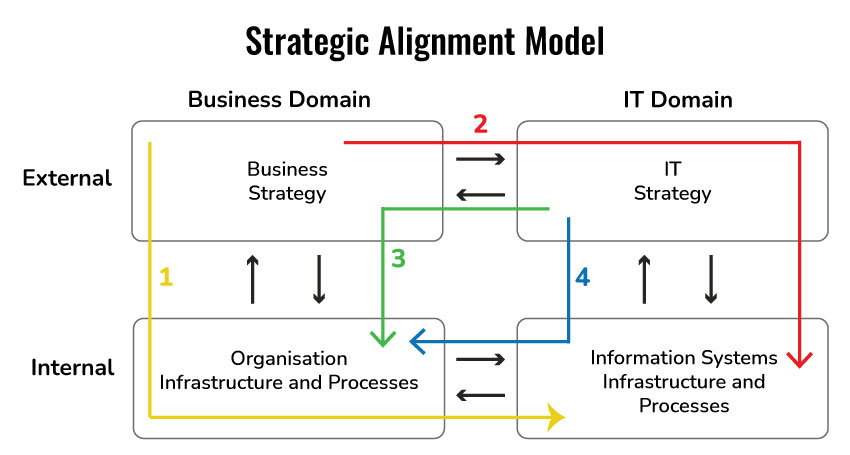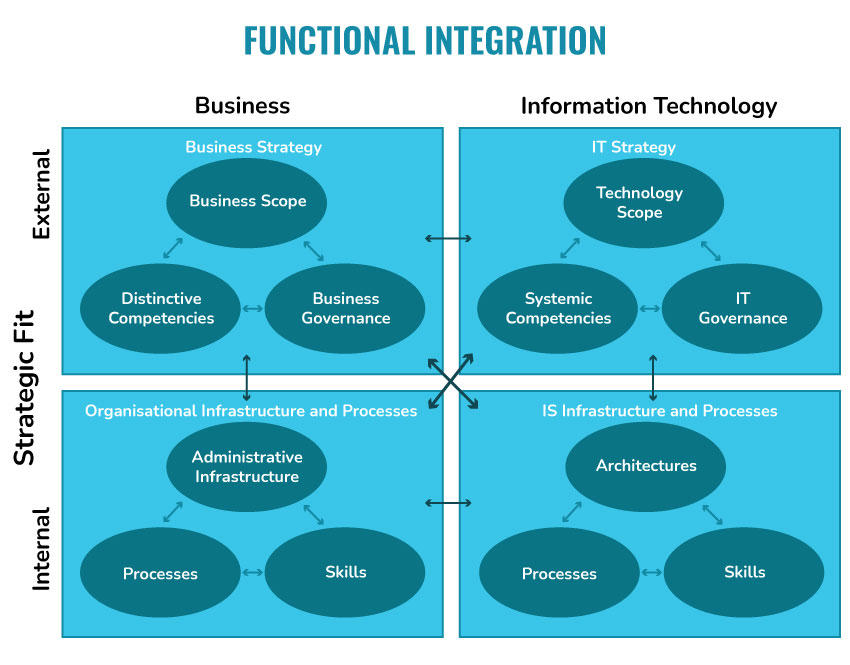Table of Content
Introduction to Strategic Alignment Model
The strategic Alignment Model given by Henderson and Venkatraman is one of the important strategic planning models that is used by the organization by focusing on two major functions: Strategic Fit and Functional Integration.
The strategic Fit includes concurrence between the internal and external business situations and the Functional Integration involves integration and alignment of the business and IT strategies of the organization. The focus of this model is on the company’s missions and its resources to attain the best results.
This model is aimed at ensuring strategic alignment in the organization from four different perspectives which include business strategy, IT strategy, organizational infrastructure, and IT infrastructure.

The need for the Strategic Alignment Model
We all know that in order to survive and prosper, organizations need to adopt diverse strategies to support innovation and growth in organizations. The strategic vision guides the overall working of the business organizations and depending on the speed of change, the senior leaders are required to formulate different strategies.

Now, you must be thinking about how diverse strategies in the organizations are managed and the simple answer to this question is Strategic Alignment which involves the process of working with business units, departments, and teams to connect various Strategies and strategic efforts to achieve organizational goals, objectives, and vision. The use of the Strategic Alignment Model also helps to ensure higher efficiency in the business operations by developing specific action plans with a focus on achieving common goals and objectives. The key benefits of the Strategic Alignment Model include preventing wastage, achieving greater differentiation, creating unique capabilities, achieving competitive advantage, and delivering higher value to the stakeholders. The Strategic Alignment Model is mainly used by organizations to develop and align business strategies in accordance with the mission and vision of the organization.
How to apply the Strategic Alignment Model?
The main focus of this model is towards the alignment of Business and IT strategies of the organization. The four different perspectives that are considered while applying this model include strategic execution, technological potential, competitive potential, and service level.
While undertaking strategic execution, the organization views business strategy as a driver of organization design choices and the business infrastructure. The second step in the implementation of the Strategic Alignment Model is technological potential that views business strategy as a driver but it is necessary to consider that the individual also needs to articulate the IT strategies to support business strategies. Thus, the technological vision and IT technical staff should be identified to facilitate the business infrastructure needed to support IT and Business strategies.
After considering the Business and IT strategies, the individual also needs to focus on the competitive potential of the organization on the basis of the business scope, business governance, strategic attributes, etc. The last step in this model is service level which focuses on building the world-class IT/ IS organization systems in the organization.
Now, you must be wondering how this model helps in strategic planning. The answer to this question is also simple. The use of this model helps in integrating not only the business and IT strategies but also the organization’s infrastructure and processes by identifying the gaps and improving the organization’s work systems. Further, on the basis of gaps in organization, the following steps are followed-
- Outlining organization’s mission and actions
- Identification of successful strategies and the strategies that need to be changed
- Determining how the change will be undertaken
- Implementing the new strategy through a change process.
Thus, this model is very useful for the business organization that wants to identify the reason for the lack of fulfillment of its goals and wants to fine-tune its objective.
Strategic Alignment Model real example
Let’s take the example of Mcdonald’s to help you better understand the Strategic Alignment Model.
The business strategy of Mcdonald’s is focused on making fast food items available to the customers at low prices. Further, Mcdonald’s uses a combination of cost leadership and international market expansion strategies to effectively meet the needs of diverse customers. Further, the company is currently aligning its business strategies with IT strategies by promoting the use of Big data and AI to effectively manage its supply chains. Not just this, the focus on improving customer service also has resulted in improvement of the IT infrastructure of McDonald’s, and the company in the current times has acquired an Israel-based tech company i.e. Dynamic Yield' which helps to dynamically change the menus when a customer places the order. However, the strategic integration is not enough for Mcdonald’s in the current times as the company still has limited healthy food menus which result in higher customer dissatisfaction. Thus, considering the strategic mission of McDonald’s, the strategic plan is prepared as follows-
| Strategic Alignment Model | Details |
|---|---|
| Mission | To make delicious food for everyone and to be one of the favorite places for customers. |
| Actions |
|
| Successful strategies |
|
| New strategie |
|
| How to undertake the change |
|